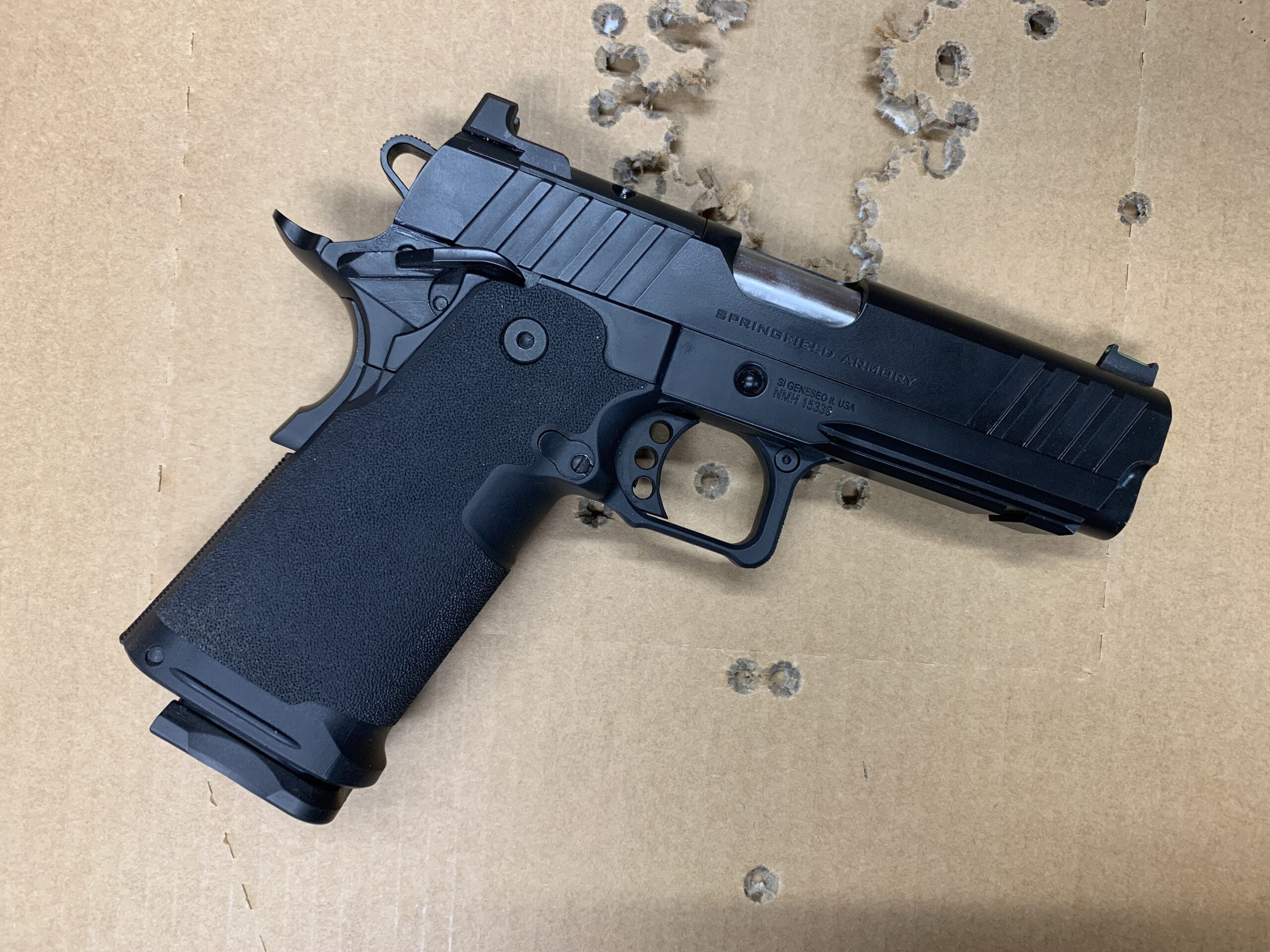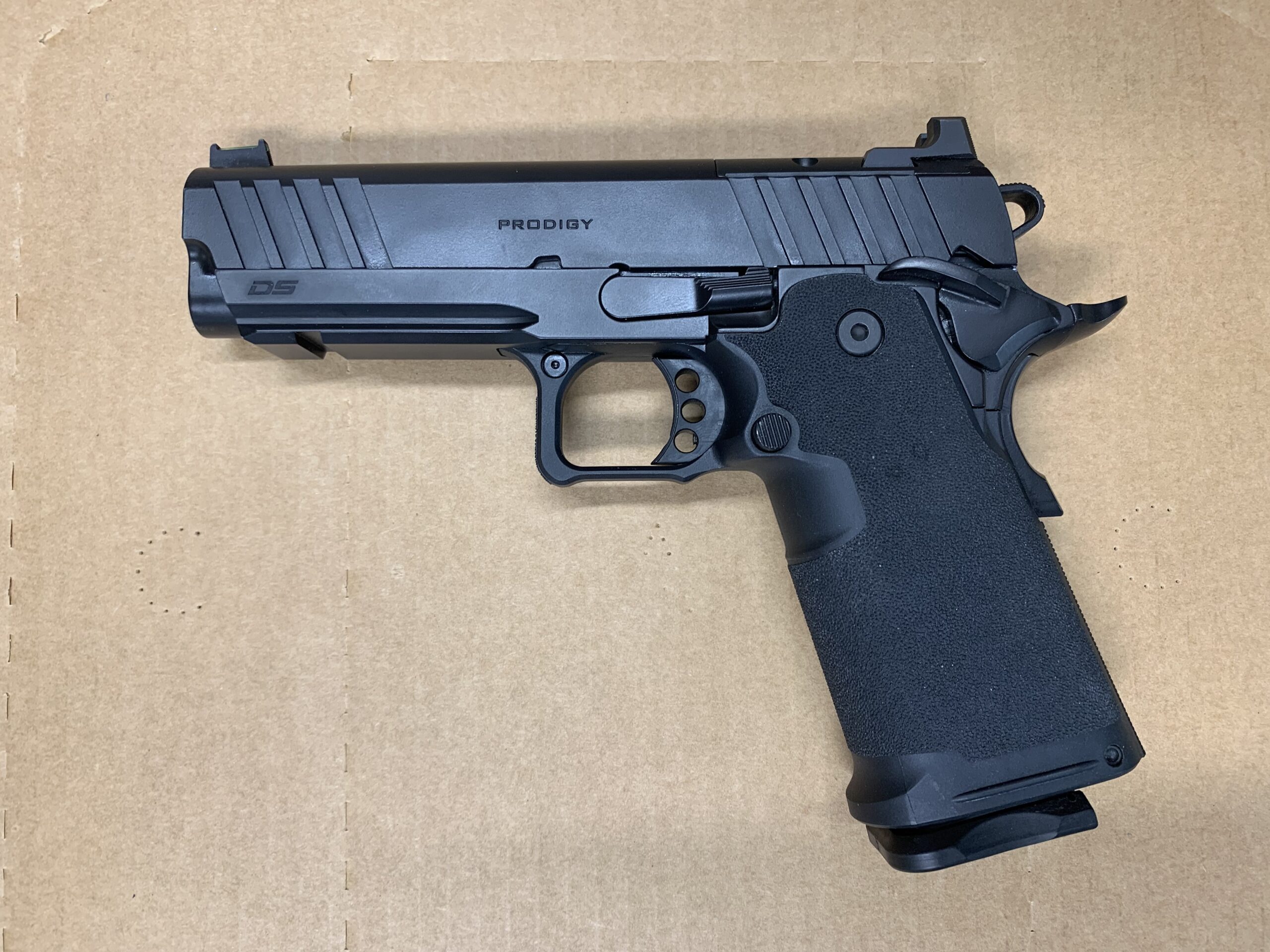We might earn income from the merchandise obtainable on this web page and take part in affiliate packages. Learn More ›
In September of final yr, Springfield Armory made waves once they introduced their new pistol: the 1911 DS Prodigy. The Springfield Prodigy is obtainable in 4.25- and 5-inch fashions and was instantly seen as heaven-sent by some; a general-production, more-affordable 2011-style 9mm pistol for the lots. Others considered the brand new pistol with incredulity, not believing it to be definitely worth the vaunted “2011” designation. My solely certainty was that I wished to check it for myself.
1911 Vs. 2011
The 1911 wants no introduction, and 1911 pistols have been round for greater than a century at this level. The 2011 is a more moderen phenomenon. Chances are that even should you don’t know what a 2011 is, you’ve heard that they’re particular; one thing to be spoken about in hushed tones and never immediately gazed upon.
In actuality, it’s fairly easy, the 2011 is a Staccato. The firm previously referred to as STI was reborn as Staccato and trademarked the nomenclature “2011.” You’ll nonetheless hear and see of us referring to equally styled pistols as “2011’s,” however lots of them technically aren’t.
When you hear or see somebody discuss with a pistol as a 2011, and it’s not a Staccato, they’re referring to a few of the fundamental design options that the pistols share. In rudimentary phrases, a 2011 or 2011-style pistol is only a double-stack 1911 that’s chambered in 9mm. Unlike a conventional 1911, which has a body that makes that up the deal with and has grip scales on each side, a 2011-style pistol’s body terminates on the prime of the grip. It makes use of a grip module, normally polymer, that attaches to the body.
The Springfield 1911 DS Prodigy is analogous in some ways to the Staccato P mannequin pistol, and far of the preliminary buzz across the Springfield Prodigy is about whether or not it’s a extra inexpensive competitor to the premium-priced 2011’s and different 2011-style pistols.
- Caliber: 9mm
- Capacity: 17+1 or 20+1
- Action: Single-action, hammer-fired
- Barrel: 4.25-inch, bull profile, chrome steel, 1:16-inch twist
- Dimensions: 7.8 inches (L) x 5.5 inches (H) x 1.28 inches (W)
- Weight: 37 ounces (w/empty 17-round journal) (weighed)
- Frame: Carbon metal, solid
- Slide: Carbon metal, solid
- Optics: Cut for optic, makes use of Agency Arms adapter plates
- Controls: Right-handed slide cease, magazine catch, ambidextrous security levers
- Finish: Black Cerakote
- Grip: Polymer grip module, nice stipple texture
- Sights: Fiber-optic entrance, serrated black “U-notch” rear (drift adjustable
- Trigger: Aluminum, single-action, curved shoe, 4 kilos, 0 ounces (measured)
- MSRP: $1499
Frame and Slide
The slide and body of the Springfield Prodigy are each solid carbon metal and match exactly collectively. The slide has a standard 1911-style profile and easy diagonal cocking serrations on each back and front. The metal/fiber-optic entrance sight is fitted into the slide by way of a dovetail. The Firing pin, firing pin spring, and extractor look and performance as they might on any 1911.
The rear/prime of the slide is reduce for mounting a pink dot optic however features a rounded cowl plate with a tall black serrated rear sight put in. A model of the Prodigy is on the market with Springfield’s Hex Dragonfly optic put in from the manufacturing unit. Agency Arms makes the optic adapter plates which can be obtainable by way of Springfield for a wide range of different optic footprints. A novel and good characteristic is that the plates drop right into a half-dovetail on the rear of the optic reduce. This ought to assist assist the plate and stop all of the shear drive from going into the screws when the gun is fired.
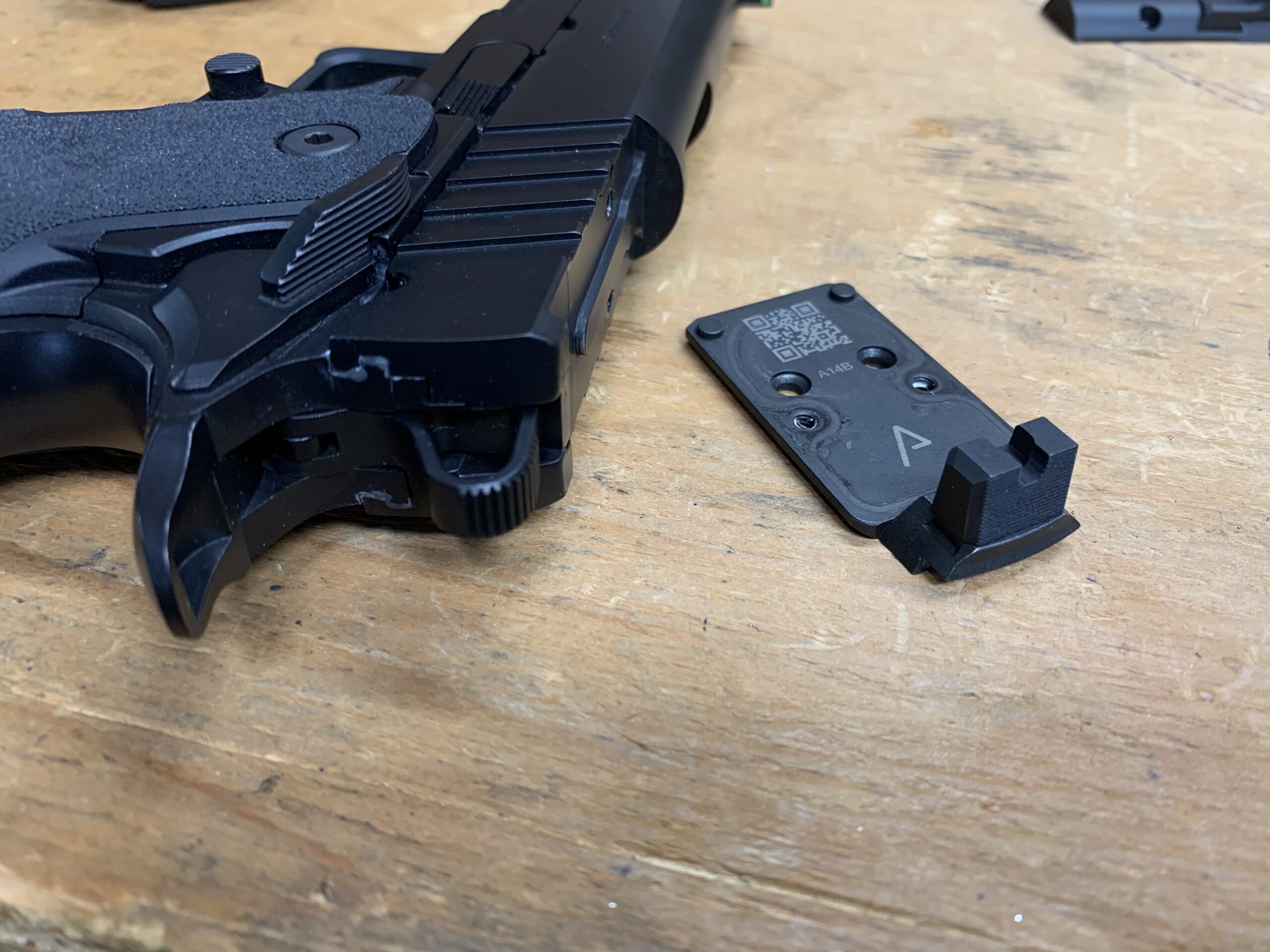
The body has a single-slot accent rail for attaching a light-weight and the slide and body are each completed with black Cerakote. Cerakote is an attention-grabbing alternative, maybe extra inexpensive, for coating the slide and body. It seems to be okay, however does really feel extra like a painted coating, which it’s, than a blued or DLC end.
Many pistols characteristic DLC-type finishes which can be sturdy and never paint-like. Cerakote finishes are widespread on up to date looking rifles, however they do present put on relatively rapidly on bearing surfaces between transferring components. Carbon metal rusts in a short time if not coated or saved oiled, so it’s one thing a consumer ought to monitor.
Grip Module
The Springfield Prodigy has a thick-but-comfortable grip. The polymer grip module is noticeably beefier than a single-stack 1911 grip and even that of many double-stack striker-fired pistols. Still, it’s simple to discover a safe and repeatable grip. The grip has a nice stipple texture on the edges and entrance, and a checkered texture on the backstrap under the grip security.
A small space under the set off guard is barely recessed and {smooth}, permitting the shooter to choke up in opposition to the set off guard. The entrance of the set off guard has a small little bit of the nice stipple texturing, however the set off guard itself has beveled edges that mesh properly with the fingers on the robust and assist palms as they press in opposition to it.
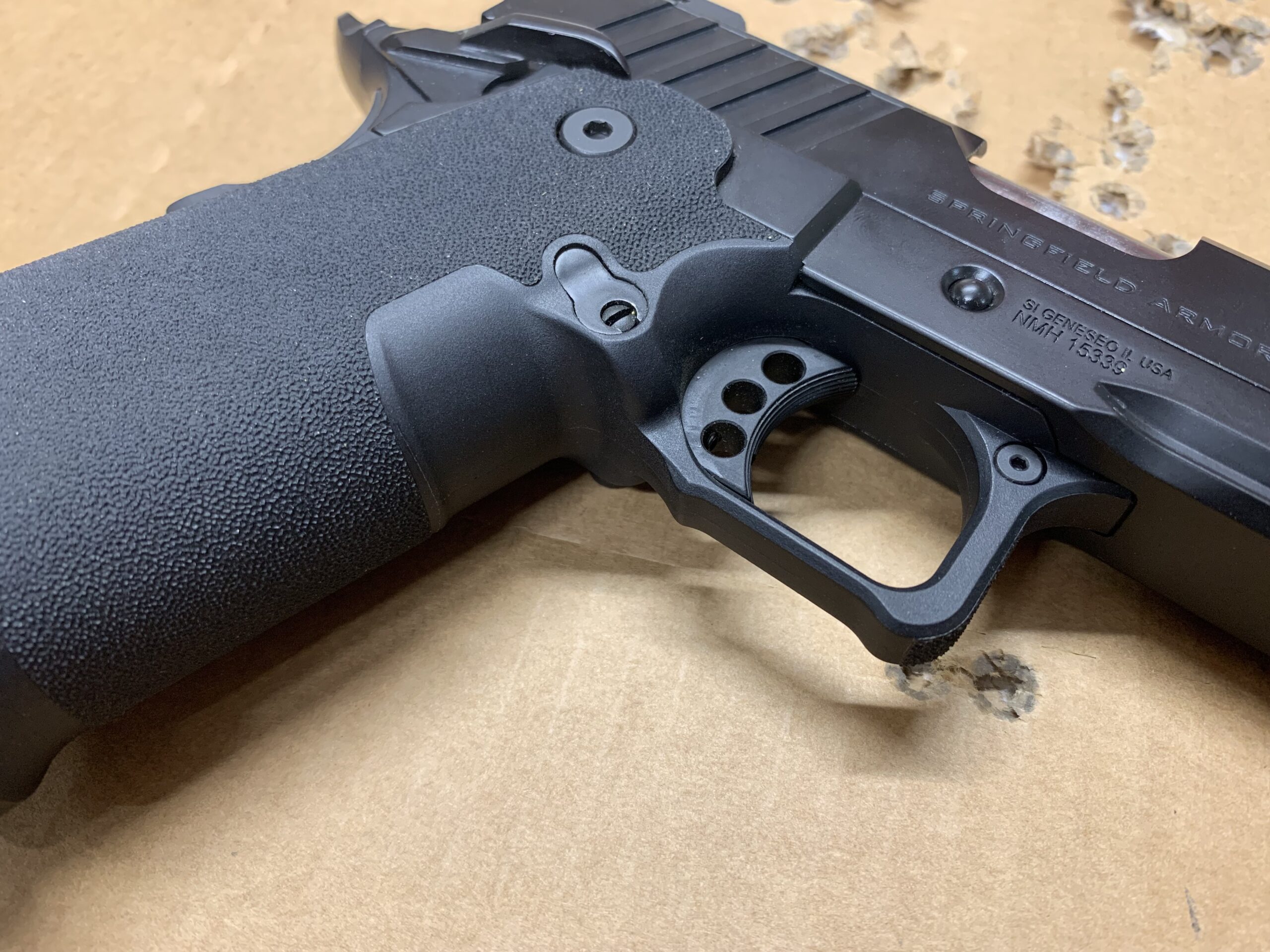
Trigger and Controls
The set off on the Springfield Prodigy has a curved shoe that’s fabricated from aluminum. It has a small set screw to manage overtravel that’s set from the manufacturing unit. The journal catch button is barely prolonged and has a serrated/ribbed texture. The thumb security has a medium-long sweeping beavertail.
Controls are predominately righthanded on this pistol, but it surely options twin security levers that give it some ambidextrous operate. The journal catch will not be reversible.
The security lever is straightforward to achieve and provides numerous actual property to relaxation my thumb on. It disengages with an audible and tactile “click.” However, when the protection is disengaged, there’s a little bit of cushion on the backside—one thing you gained’t see on high-end 1911’s and 2011-style pistols. After clicking the protection off, you may press the lever down one other .063 inches. Let go and spring rigidity will convey it again. This won’t be an enormous deal to you, however some shooters get persnickety about issues like that.
Barrel and Internals
The barrel on the Prodigy is solid from stainless-steel. It’s a bushing-free bull-profile barrel that’s 4.25 inches lengthy and .695 inches in diameter on the muzzle. It tapers down barely, again in direction of the 2 locking lugs, and options the basic 1911 rotating barrel hyperlink.
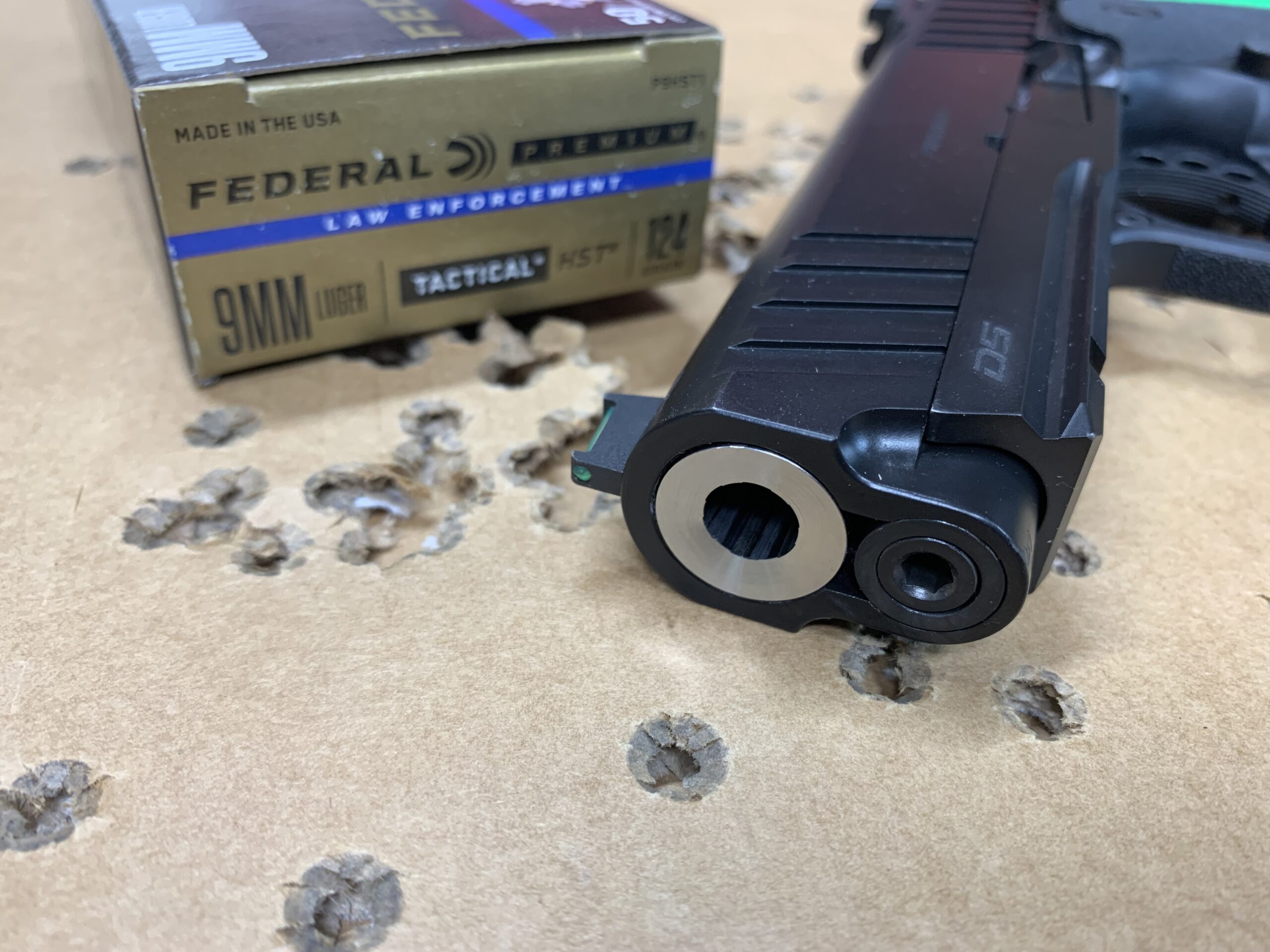
The Springfield Prodigy comes with a two-piece information rod that acts as a full-length rod when assembled. The again half is sort of a GI-length information rod however threaded on the top. The recoil spring is positioned over the rear portion of the information rod, then when put in below the barrel, the spring is slid into an open-ended spring plug. The entrance half of the information rod is then pushed from the entrance, by way of the spring, and threaded onto the rear portion of the information rod. It’s tightened with an Allen key.
Many of the inner components, some extent of ire with some reviewers, are injection-molded and never solid. Forged and hand-fit components are nicer, however plug-and-play components aren’t essentially a nasty factor. Many weapons use injection-molded steel components to chop prices and velocity up manufacturing. Even the hottest-shit Sig P365s, Glocks, or M&Ps are filled with stamped and molded components.
Magazines
The Springfield Prodigy comes with a 17- and a 20-round journal. The magazines are made by Duramag and seem like effectively constructed. They have a black-finished metal physique, metal spring, polymer followers, and polymer baseplates. They look much like Staccato 2011 magazines and can operate in a Staccato P.
Staccato magazines may even operate within the Prodigy, and a few early run customers reported feeding points with the manufacturing unit magazines that had been remedied by switching to Staccato model mags. The Staccato magazines solely value about $10 greater than the Springfield mags so, if feeding is a matter, it might be value attempting one. I did discover that the manufacturing unit magazines had been just a little finicky to load and when totally loaded, there was normally a spherical or two rattling within the journal; that didn’t appear to have an effect on feeding or reliability with my pattern.
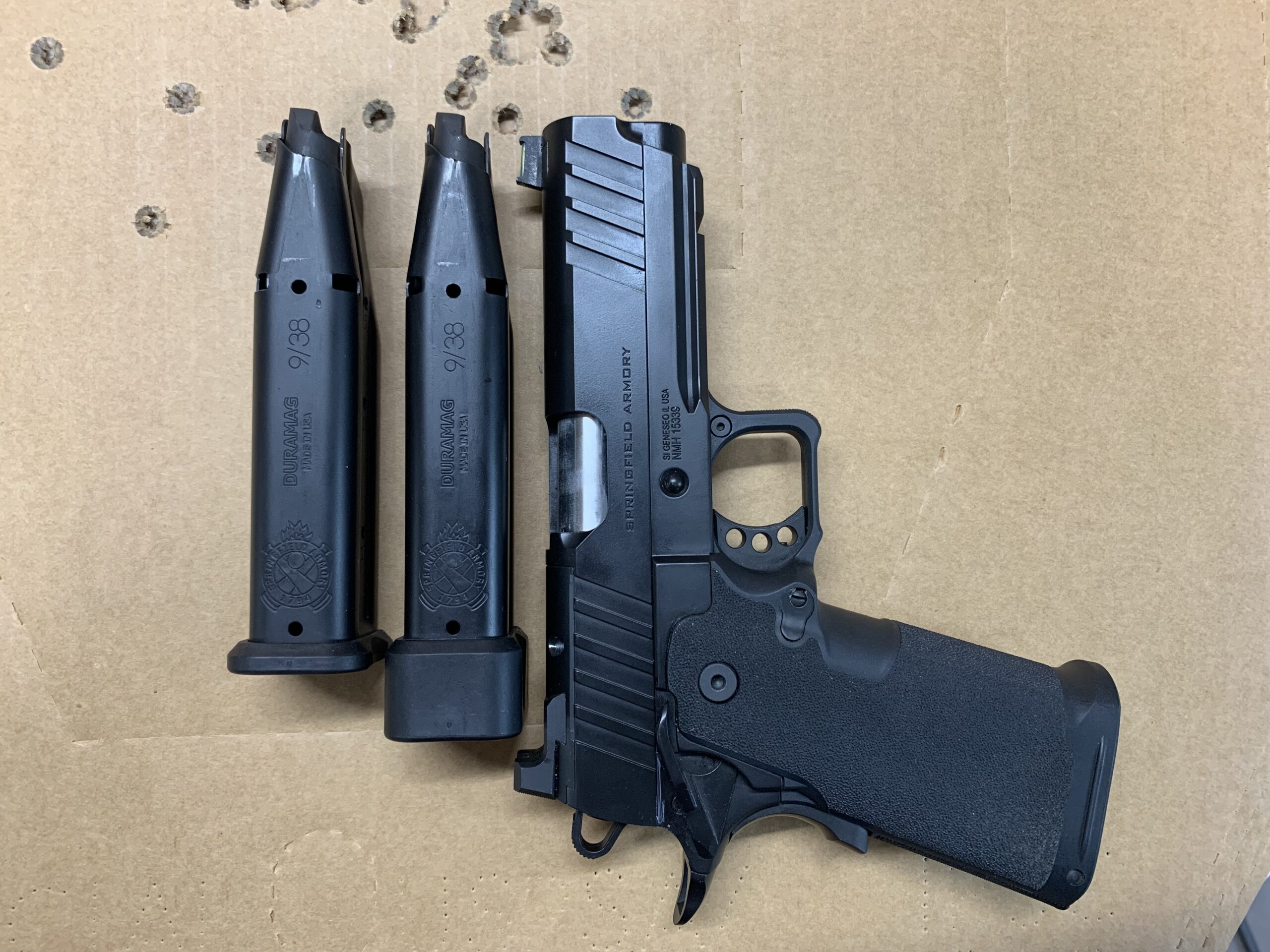
The Springfield 1911 DS Prodigy 4.25-Inch on the Range
I used to be desirous to see how easily the Springfield Prodigy would run, how simple it might be to take care of a very good grip and run quick repeatable pictures, and finally, how dependable it might be. I acquired my pattern in December, which gave me the good thing about snooping round to see what early reviewers and people that know 1911’s and 2011’s higher than I do needed to say. Early outcomes and opinions had been actually combined. It’s widespread for brand new releases to have some bugs that want figuring out; now I’d know what points to search for.
It typically takes 100 to 200 rounds to interrupt in a handgun and I’ll normally really feel snug reviewing one after firing 300 rounds or so. With some early revealed opinions knocking the gun for reliability points, I made a decision to place at the least a thousand rounds by way of the gun earlier than passing judgement.
On the vary, I consider handguns in three totally different areas: dealing with, sensible accuracy, and reliability.
How the Springfield Prodigy Handles
I just like the grip on the Prodigy. The stippling texture provides me good traction and there’s loads of actual property for my support-hand to achieve some buy on the grip too. It feels and factors like a thick-waisted 1911. The cocking serrations chunk exhausting and supply loads of buy. I prefer to rack pistols from the entrance of the slide with my thumb and the net of my hand; it’s easy with this pistol. Slide manipulation is butter-smooth, and I can detect solely a tiny quantity of slop or motion within the slide/body interface—even after 1,000 rounds.
The set off is superb on my Prodigy, and it breaks cleanly at 4 kilos even (as measured on my Lyman set off pull scale). I’ve felt higher triggers on race weapons just like the CZ TS 2 Racing Green, however this one had a brief take-up, broke clear, and was a pair ounces lighter than the set off on the Staccato P that I’ve.
Loaded magazines snap into the grip module simply and racking the primary spherical is {smooth}. With the beavertail on the grip security, it’s simple to index a rock-solid grip to drive this gun. The journal catch requires a slight repositioning of the hand for me to achieve, but it surely’s nonetheless simple and intuitive. The Prodigy doesn’t embrace a magwell, however the inside edges of the grip are beveled and obtain the bottlenecked magazines simply. Empty mags all fall free from the grip for me when engaged on speedy reloads from a gunbelt.
My solely grievance in regards to the controls of the Springfield Prodigy is that the slide cease is tough to have interaction manually. The slide cease lever is sunk into the body to make it flush with the body and the top is hard to govern; it’s very tough to do one-handed. It’s additionally tough to drop the slide with the taking pictures hand thumb. With the thumb security depressed, the Springfield Prodigy’s grip is roughly 0.063 inches longer, front-to-back, than the Staccato P’s grip. That distinction isn’t huge, but it surely makes it typically essential to function the Prodigy’s slide cease with my support-hand thumb. I can’t attain it with my proper thumb with out breaking grip.

I’ve the nice fortune of attending to shoot fairly a number of pistols, and I consider I’ve fired near 10,000 rounds of 9mm within the final twelve months. I can say with confidence that the Springfield Prodigy is without doubt one of the quickest and smoothest-shooting pistols I’ve fired in a very long time. The CZ TS 2, Nighthawk Custom President, and Staccato P, are the one pistols I’ve fired within the final yr that edge it out in smoothness, controllability, and pure pleasure.
The clear break of the Prodigy’s set off is adopted by a delicate and fast recoil and return to battery. When gripping the pistol correctly, the entrance sight snaps proper again to the place it was when the set off broke. I’ll not laud it to the purpose of nausea, however taking pictures it made me wish to throw my G19 within the rubbish can after leaving the vary.
How Accurate is the Springfield Prodigy?
I shot the Springfield Prodigy with each iron sights and a Trijicon RMR. It’s simple to shoot precisely with each, and I famous that the iron sights are tall sufficient to co-witness by way of the optic. That’s a pleasant characteristic in case your battery fails at a nasty time. Like many 1911-style pistols, the Prodigy factors naturally, and the clean-breaking set off makes it simple to position rounds the place they should go.
I didn’t spend lots of time taking pictures measured teams, however with a red-dot, I might simply preserve two-handed un-supported pictures inside a three-inch goal sticker at 50 toes. Maintaining a decent cluster within the A-zone on a USPSA/IPSC goal whereas taking pictures solely sluggish sufficient to catch the reset was a breeze. It’s a pistol that lends itself to forgiving, correct taking pictures; actually, correct sufficient for an entry-level aggressive 2011-style pistol.
Another means I prefer to gauge how simply a pistol is to shoot precisely, and enhance my abilities, is to fireside counted strings as quick as attainable at a USPSA/IPSC goal at 21 toes. I’ll fireplace strings of 1, two, three, 4, and 5 rounds as quick as I can, engaged on sustaining my grip and sight image. After most classes of 150 to 200 rounds, solely 4 or 5 pictures had discovered their means outdoors the “A-zone” and the middle was a ragged gap. It’s a straightforward gun to shoot effectively.

Is the Springfield Prodigy Reliable?
I couldn’t ignore a few of the opinions and movies discussing the problems that some early 1911 DS Prodigy consumers and reviewers encountered. I’d seen experiences of feeding points brought on by each magazines and the slide being slowed down by a stiff disconnector on some pistols. I’d heard of some set off points too. Most of the reliability points had been being blamed on the injection-molded inside components.
I hoped that my pattern, which was a number of months after the primary run, would have these points ironed out. Running over 1,000 rounds by way of the gun would absolutely reveal any hidden reliability points, and I’m happy to report that my pattern ran like a scalded canine.
Read Next: Favorite Guns of 2022
I encountered 5 whole malfunctions, within the roughly 1,100 rounds fired. All 5 had been with 115-grain Federal Syntech flat-nose manufacturing unit hundreds. I had three rounds stick on the feed ramp within the first journal I fired by way of the gun when new. After that, the one hiccups I had had been two feed ramp sticks in a single journal with the identical ammo whereas taking pictures weak-hand-only. That was after not cleansing the gun for 300 rounds or so. I concluded that the issue was a matter of my limp left wrist relatively than the gun. I can’t converse for all of the Springfield Prodigy pistols on the market, however I will surely vouch for this one’s reliability. I fired all kinds of ammunition with the Prodigy: 115-, 124-, and 147-grain Federal flat-nose Syntech ammunition, 115- and 124-grain Remington UMC, 124-grain Federal HST hollowpoints, 90-grain +P Black Hills Honey Badger, 135-grain Federal Hydra Shok, 147-grain Federal HST hollowpoints, 147-grain Hornady XTP hollowpoints, Winchester 147-grain FMJ, Nosler 147-grain ASP hollowpoints, and Federal Premium 147-grain +P Solid Core ammunition.
The one reliability-related element I’d critique is the two-piece information rod. I didn’t have any performance points with it, however on the finish of every taking pictures session, it was not tight. Since it’s essential to disassemble the rod to scrub the pistol, it’s not a component you wish to put thread-locker on. Just keep watch over it.
What the Springfield Prodigy Does Well
I believe the Springfield Prodigy brings lots of efficiency for its value level. It has an ultra-smooth slide-to-frame match and a pleasant barrel. The grip module is properly profiled and textured, the set off is nice, and it’s a enjoyable and quick gun to shoot.
Where the Springfield Prodigy Could Be Better
The greatest ways in which the Prodigy might be higher are a barely shorter (front-to-back) grip that permits one-handed operation of the controls. A slide cease that’s simpler to function can be a plus too. I’d additionally desire a information rod design that doesn’t loosen as simply.
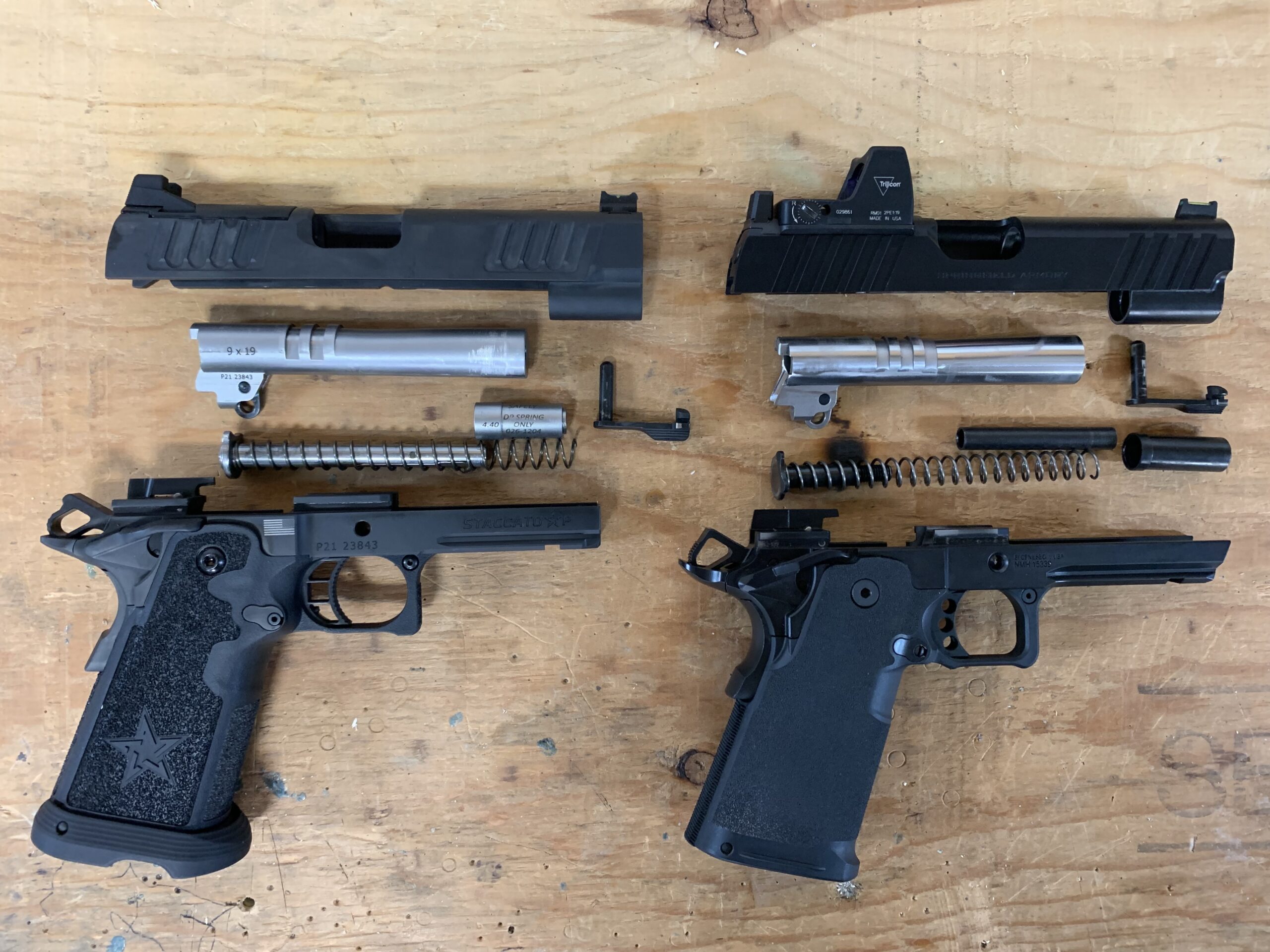
Final Thoughts
For many shooters, the 2011-style pistol has been nothing greater than aspirational; a real STI or Staccato on the native vary is one thing particular that folks nonetheless stroll over to take a look at. With a big-name firm like Springfield Armory bringing a 2011-style pistol to market, the burning query across the Springfield Prodigy is: how does it examine?
The query is completely comprehensible, however I believe it’s the flawed one to ask. They’re two totally different weapons which can be a couple of thousand bucks aside in value. They’re actually focusing on totally different market segments altogether. The most comparable 2011, the Staccato P, seems to be lots just like the 1911 DS Prodigy, however its supplies, components, finishes, and a spotlight to element put it in a unique class than any mass-produced pistol. The Prodigy is an excellent-shooting pistol that feels lots just like the Staccato P, but when the real article is what you need, simply shell out and purchase it. The Staccatos have loads of considerable qualities that justify the upper price ticket.
To be really honest to the Springfield Prodigy, it ought to solely be in comparison with the Staccato in model solely. It’s an correct, quick, smooth-shooting pistol that’s a stable performer for its value. The Prodigy is a wonderful choice for somebody who’s eager to get a good-quality entry-level double-stack 1911 for enjoyable or to compete with. A $1,500 pistol isn’t precisely low cost however, just like the considerable hole between the Springfield Prodigy and premium 2011-style pistols, the Prodigy I examined was in a unique league than simply about any $600 to $1,300 striker-fired pistol I’ve shot.



